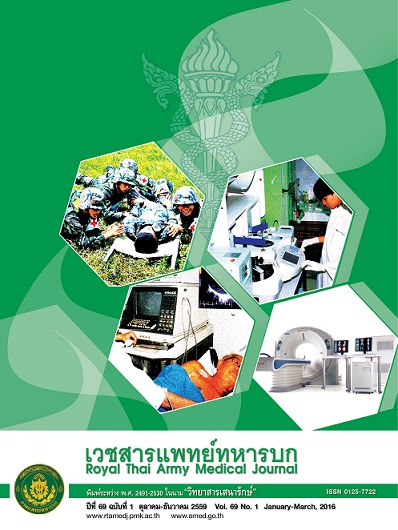การเปรียบเทียบความหนาแน่นของมวลกระดูกของนักเรียนแพทย์ทหารและนักศึกษาแพทย์ชั้นปีที่ 2 วิทยาลัยแพทยศาสตร์พระมงกุฎเกล้า ปีการศึกษา 2554 ก่อนและหลังจากได้รับการฝึกโดยใช้เครื่อง อัลตร้าซาวด์วัดความหนาแน่นของมวลกระดูก
Main Article Content
Abstract
บทนำ: การออกกำลังกายที่มีการลงน้ำหนักเป็นประจำเชื่อว่าจะทำให้ความหนาแน่นของมวลกระดูกเพิ่มขึ้น นักเรียนแพทย์ทหารและนักศึกษาแพทย์ชั้นปีที่ 2 ของวิทยาลัยแพทยศาสตร์พระมงกุฎเกล้า จะได้รับการฝึกวิชาทหารและปรับสภาพร่างกาย ซึ่งจะมีการออกกำลังกายที่มีการลงน้ำหนักอย่างเป็นประจำเกือบตลอดทั้งปี ซึ่งน่าจะมีผลต่อความหนาแน่นของมวลกระดูก วัตถุประสงค์: เพื่อเปรียบเทียบความหนาแน่นของมวลกระดูกในช่วงก่อนและหลังได้รับการฝึกห่างกันประมาณ 6 เดือน โดยใช้เครื่องอัลตร้าซาวด์วัดกระดูกส้นเท้า เครี่องมือและวิธีการวิจัย : เป็นการวิจัยเชิงวิเคราะห์ ณ จุดเวลาใด เวลาหนึ่ง โดยประชากรที่ศึกษา คือ นักเรียนแพทย์ทหารและนักศึกษาแพทย์ ชั้น ปีที่ 2 วิทยาลัยแพทยศาสตร์พระมงกุฎเกล้า ปีการศึกษา 2554 จำนวน 80 คน แบ่งเป็นผู้ชาย 41 คนและผู้หญิง 39 คน โดยใช้เครื่องอัลตร้าซาวด์ (QUS devices, the Sahara ; Hologic Inc., Bedford, MA) วัดที่ส้นเท้าขวาเพื่อหาค่าความหนาแน่นมวลกระดูก (BMD), ค่า broadband ultrasound attenuation (BUA) และค่า speed of sound (SOS) และวิเคราะห์เปรียบเทียบความแตกต่างของค่าความหนาแน่นมวลกระดูก ทั้ง 2 ครั้ง โดยใช้สถิติแบบ paired t-test ผลการวิจัย: พบว่า ภายหลังการฝึก 6 เดือน นักเรียนแพทย์ทหารและนักศึกษาแพทย์ ชั้น ปีที่ 2 วิทยาลัยแพทยศาสตร์พระมงกุฎเกล้า ปีการศึกษา 2554 มีค่าเฉลี่ย BMD(gm/cm2), BUA(dB/ MHz) และ SOS(m/s) ในผู้ชายเท่ากับ 0.74, 98.87 และ 1598.17 ในผู้หญิงเท่ากับ 0.79, 104.43 และ 1601.49 เปรียบเทียบกับก่อนการฝึก พบว่ามีค่าเฉลี่ย BMD(gm/cm2), BUA(dB/ MHz) และ SOS(m/s) ในผู้ชายเท่ากับ 0.63, 89.17 และ 1577.02 ในผู้หญิงเท่ากับ 0.62, 86.95 และ 1576.04 พบว่าภายหลังการฝึกวิชาทหารและปรับสภาพร่างกายมีค่า BMD, BUA และSOS สูงขึ้น อย่างมีนัยสำคัญทางสถิติ (P < 0.0001) สรุป: การฝึกวิชาทหารและปรับสภาพร่างกายน่าจะมีประโยชน์ทำให้ความหนาแน่นของมวลกระดูกเพิ่มขึ้น
The comparison of the bone mineral density of medical cadets and medical students in second year academic class of 2011 before and after training exercises by using quantitative ultrasound device.
Introduction: The weight bearing exercise is believed to increase bone mineral density. The second year medical cadet and medical student training program include regular weight bearing exercise. The purpose of this cross-sectional analytic study was to compare bone mineral density of the medical cadets and medical students in 2nd year academic class of 2011 after 6-month duration of training exercises by using calcaneal quantitative ultrasound device. Materials and Methods: The subjects are consisted of 80 healthy medical cadets and medical students in 2nd year academic class of 2011, age ranging from 19 to 22 years which were divided into 41 male subjects and 39 female subjects from Phramongkutklao Medical College. The quantitative ultrasound (QUS) device, the Sahara; Hologic was used to measure bone mineral density (BMD), Broadband Ultrasound Attenuation (BUA) and Speed of Sound (SOS) in which the measurements were focused at the right calcaneus. The statistical method for analyzing the data was paired t-test Results: The mean BMD (g/cm2), BUA (dB/MHz) and SOS (m/s) after training exercises for 6 months of the medical cadets and medical students in second year class of 2011 academic year were 0.74, 98.87, and 1,598.17, respectively in male and 0.79, 104.43, and 1,601.49, respectively in female as compared with the mean BMD (g/cm2), BUA (dB/MHz) and SOS (m/s) before training which were 0.63, 89.17, and 1,577.02, respectively in male and 0.62, 86.95, and 1,576.04, respectively in female. Conclusion: BMD, BUA and SOS after training exercises of the medical cadets and medical students in 2nd year academic class of 2011 were significantly higher than before training exercise (p < 0.0001). Therefore the training exercise program may have benefit in increasing bone mineral density.

